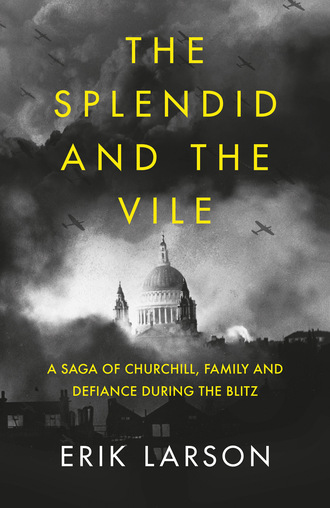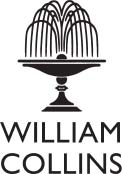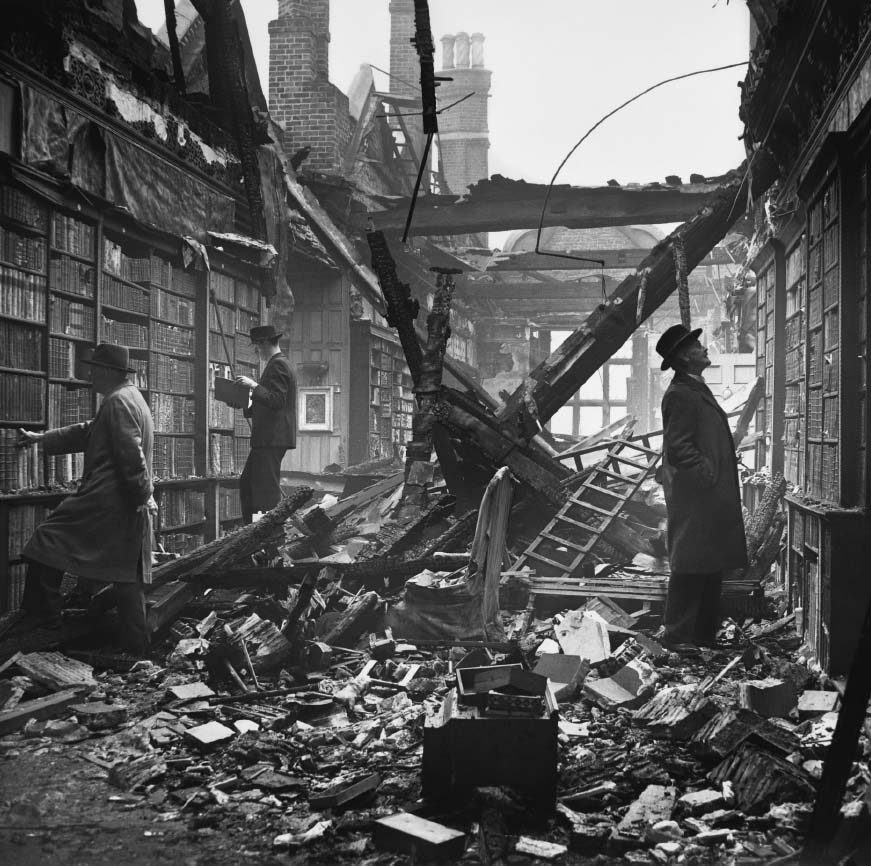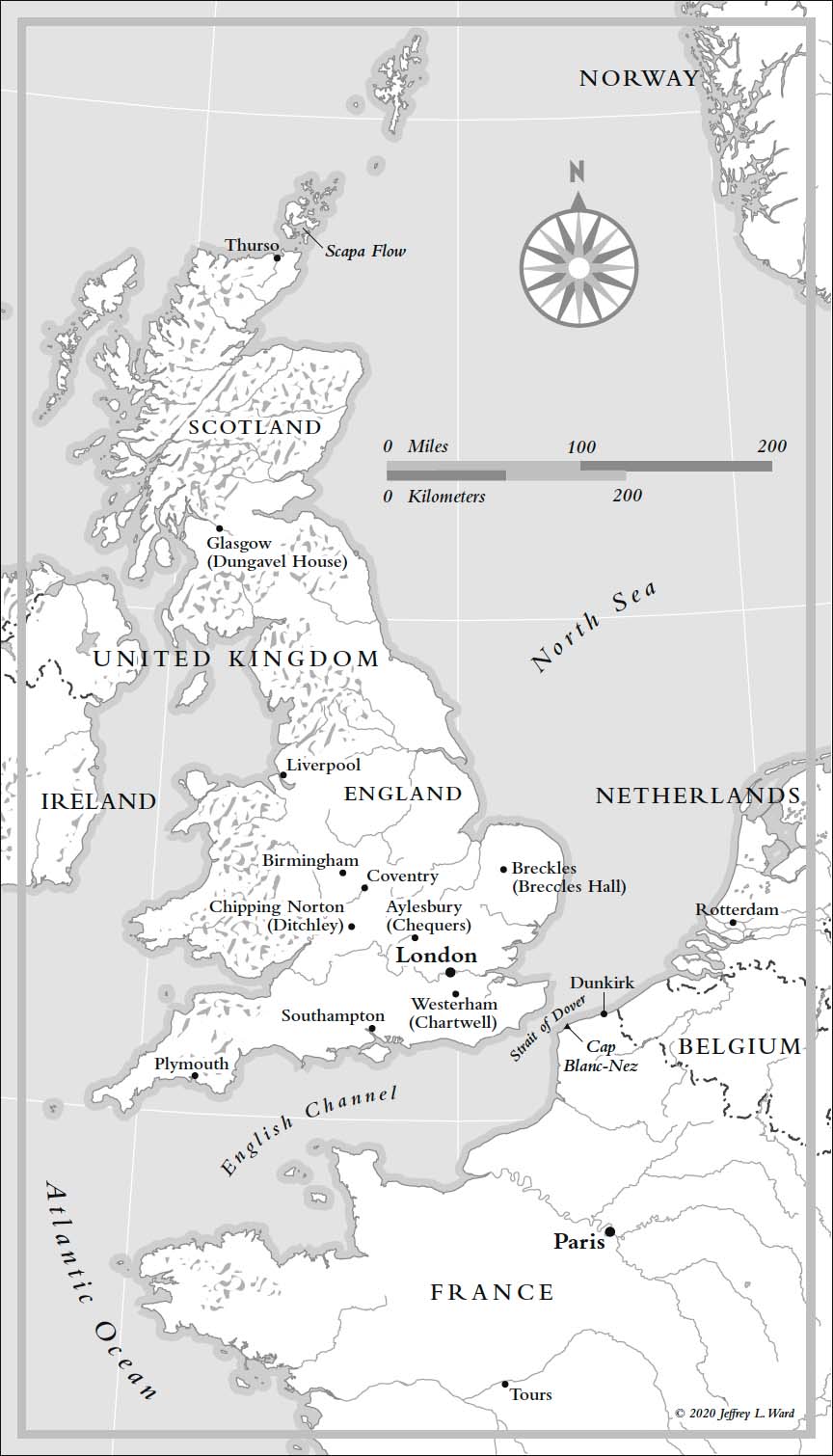
Полная версия
The Splendid and the Vile

THE SPLENDID AND THE VILE
A SAGA OF CHURCHILL, FAMILY AND DEFIANCE DURING THE BLITZ
Erik Larson

Copyright
William Collins
An imprint of HarperCollinsPublishers
1 London Bridge Street
London SE1 9GF
WilliamCollinsBooks.com
This eBook first published in Great Britain by William Collins in 2020
Copyright © Erik Larson 2020
Erik Larson asserts the moral right to be identified as the author of this work
Frontispiece photograph: Central Press/Hulton Archive/Getty Images
Jacket photographs: St Paul’s © Associated Newspapers/Getty Images
Planes © London Express/Stringer
Map by Jeffrey L. Ward
A catalogue record for this book is available from the British Library
All rights reserved under International and Pan-American Copyright Conventions. By payment of the required fees, you have been granted the non-exclusive, non-transferable right to access and read the text of this e-book on-screen. No part of this text may be reproduced, transmitted, down-loaded, decompiled, reverse engineered, or stored in or introduced into any information storage and retrieval system, in any form or by any means, whether electronic or mechanical, now known or hereinafter invented, without the express written permission of HarperCollins
Source ISBN: 9780008274948
Ebook Edition © March 2020 ISBN: 9780008274955
Version: 2020-02-05
Frontispiece

Dedication
To David Woodrum
—for secret reasons
Epigraph
It is not given to human beings—happily for them, for otherwise life would be intolerable—to foresee or to predict to any large extent the unfolding course of events.
—WINSTON CHURCHILL,
EULOGY FOR NEVILLE CHAMBERLAIN,
NOVEMBER 12, 1940
Contents

Cover
Title Page
Copyright
Frontispiece
Dedication
Epigraph
A Note to Readers
Map
BLEAK EXPECTATIONS
1940
PART ONE: THE RISING THREAT
CHAPTER 1: The Coroner Departs
CHAPTER 2: A Night at the Savoy
CHAPTER 3: London and Washington
CHAPTER 4: Galvanized
CHAPTER 5: Moondread
CHAPTER 6: Göring
CHAPTER 7: Sufficient Bliss
CHAPTER 8: The First Bombs
CHAPTER 9: Mirror Image
CHAPTER 10: Apparition
PART TWO: A CERTAIN EVENTUALITY
CHAPTER 11: The Mystery of Swan Castle
CHAPTER 12: The Ghosts of Dull People
CHAPTER 13: Scarification
CHAPTER 14: “This Queer and Deadly Game”
CHAPTER 15: London and Berlin
CHAPTER 16: The Red Warning
CHAPTER 17: “Tofrek!”
CHAPTER 18: Resignation No. 1
CHAPTER 19: Force H
CHAPTER 20: Berlin
CHAPTER 21: Champagne and Garbo
CHAPTER 22: Have We Sunk So Low?
CHAPTER 23: What’s in a Name?
CHAPTER 24: The Tyrant’s Appeal
CHAPTER 25: The Prof’s Surprise
CHAPTER 26: White Gloves at Dawn
CHAPTER 27: Directive No. 17
CHAPTER 28: “Oh, Moon, Lovely Moon”
PART THREE: DREAD
CHAPTER 29: Eagle Day
CHAPTER 30: Perplexity
CHAPTER 31: Göring
CHAPTER 32: The Bomber in the Pasture
CHAPTER 33: Berlin
CHAPTER 34: Ol’ Man River
CHAPTER 35: Berlin
CHAPTER 36: Teatime
CHAPTER 37: The Lost Bombers
CHAPTER 38: Berlin
CHAPTER 39: Ah, Youth!
CHAPTER 40: Berlin and Washington
CHAPTER 41: He Is Coming
CHAPTER 42: Ominous Doings
CHAPTER 43: Cap Blanc-Nez
PART FOUR: BLOOD AND DUST
CHAPTER 44: On a Quiet Blue Day
CHAPTER 45: Unpredictable Magic
CHAPTER 46: Sleep
CHAPTER 47: Terms of Imprisonment
CHAPTER 48: Berlin
CHAPTER 49: Fear
CHAPTER 50: Hess
CHAPTER 51: Sanctuary
CHAPTER 52: Berlin
CHAPTER 53: Target Churchill
CHAPTER 54: Spendthrift
CHAPTER 55: Washington and Berlin
CHAPTER 56: The Frog Speech
CHAPTER 57: The Ovipositor
CHAPTER 58: Our Special Source
CHAPTER 59: A Coventry Farewell
CHAPTER 60: Distraction
CHAPTER 61: Special Delivery
CHAPTER 62: Directive
CHAPTER 63: That Silly Old Dollar Sign
CHAPTER 64: A Toad at the Gate
CHAPTER 65: Weihnachten
CHAPTER 66: Rumors
CHAPTER 67: Christmas
CHAPTER 68: Egglayer
CHAPTER 69: Auld Lang Syne
1941
PART FIVE: THE AMERICANS
CHAPTER 70: Secrets
CHAPTER 71: The Eleven-thirty Special
CHAPTER 72: To Scapa Flow
CHAPTER 73: “Whither Thou Goest”
CHAPTER 74: Directive No. 23
CHAPTER 75: The Coming Violence
CHAPTER 76: London, Washington, and Berlin
CHAPTER 77: Saturday Night
CHAPTER 78: The Tall Man with the Smile
CHAPTER 79: Snakehips
CHAPTER 80: Bayonet Quadrille
CHAPTER 81: The Gambler
CHAPTER 82: A Treat for Clementine
CHAPTER 83: Men
PART SIX: LOVE AMID THE FLAMES
CHAPTER 84: Grave News
CHAPTER 85: Scorn
CHAPTER 86: That Night at the Dorchester
CHAPTER 87: The White Cliffs
CHAPTER 88: Berlin
CHAPTER 89: This Scowling Valley
CHAPTER 90: Gloom
CHAPTER 91: Eric
CHAPTER 92: Le Coeur Dit
CHAPTER 93: Of Panzers and Pansies
CHAPTER 94: Le Coeur Encore
CHAPTER 95: Moonrise
PART SEVEN: ONE YEAR TO THE DAY
CHAPTER 96: A Beam Named Anton
CHAPTER 97: Interloper
CHAPTER 98: The Cruelest Raid
CHAPTER 99: A Surprise for Hitler
CHAPTER 100: Blood, Sweat, and Tears
CHAPTER 101: A Weekend at Chequers
EPILOGUE: AS TIME WENT BY
Sources and Acknowledgments
Bibliography
Index
About the Author
Also by Erik Larson
About the Publisher
A Note to Readers

IT WAS ONLY WHEN I MOVED TO MANHATTAN A FEW YEARS AGO THAT I came to understand, with sudden clarity, how different the experience of September 11, 2001, had been for New Yorkers than for those of us who watched the nightmare unfold at a distance. This was their home city under attack. Almost immediately I started thinking about London and the German aerial assault of 1940–41, and wondered how on earth anyone could have endured it: fifty-seven consecutive nights of bombing, followed by an intensifying series of nighttime raids over the next six months.
In particular I thought about Winston Churchill: How did he withstand it? And his family and friends? What was it like for him to have his city bombed for nights on end and to know full well that these air raids, however horrific, were likely only a preamble to far worse, a German invasion from the sea and sky, with parachutists dropping into his garden, panzer tanks clanking through Trafalgar Square, and poison gas wafting over the beach where once he painted the sea?
I decided to find out, and quickly came to realize that it is one thing to say “Carry on,” quite another to do it. I focused on Churchill’s first year as prime minister, May 10, 1940, to May 10, 1941, which coincided with the German air campaign as it evolved from sporadic, seemingly aimless raids to a full-on assault against the city of London. The year ended on a weekend of Vonnegutian violence, when the quotidian and the fantastic converged to mark what proved to be the first great victory of the war.
What follows is by no means a definitive account of Churchill’s life. Other authors have achieved that end, notably his indefatigable but alas not immortal biographer Martin Gilbert, whose eight-volume study should satisfy any craving for the last detail. Mine is a more intimate account that delves into how Churchill and his circle went about surviving on a daily basis: the dark moments and the light, the romantic entanglements and debacles, the sorrows and laughter, and the odd little episodes that reveal how life was really lived under Hitler’s tempest of steel. This was the year in which Churchill became Churchill, the cigar-smoking bulldog we all think we know, when he made his greatest speeches and showed the world what courage and leadership looked like.
Although at times it may appear to be otherwise, this is a work of nonfiction. Anything between quotation marks comes from some form of historical document, be it a diary, letter, memoir, or other artifact; any reference to a gesture, gaze, or smile, or any other facial reaction, comes from an account by one who witnessed it. If some of what follows challenges what you have come to believe about Churchill and this era, may I just say that history is a lively abode, full of surprises.
—ERIK LARSON
MANHATTAN, 2020
Map

Bleak Expectations

NO ONE HAD ANY DOUBT THAT THE BOMBERS WOULD COME. Defense planning began well before the war, though the planners had no specific threat in mind. Europe was Europe. If past experience was any sort of guide, a war could break out anywhere, anytime. Britain’s military leaders saw the world through the lens of the empire’s experience in the previous war, the Great War, with its mass slaughter of soldiers and civilians alike and the first systematic air raids of history, conducted over England and Scotland using bombs dropped from German zeppelins. The first of these occurred on the night of January 19, 1915, and was followed by more than fifty others, during which giant dirigibles drifting quietly over the British landscape dropped 162 tons of bombs that killed 557 people.
Since then, the bombs had grown bigger and deadlier, and more cunning, with time delays and modifications that made them shriek as they descended. One immense German bomb, a thirteen-foot, four-thousand-pounder named Satan, could destroy an entire city block. The aircraft that carried these bombs had grown larger as well, and faster, and flew higher, and were thus better able to evade home-front defenses. On November 10, 1932, Stanley Baldwin, then deputy prime minister, gave the House of Commons a forecast of what was to come: “I think it is well for the man in the street to realize that there is no power on earth that can protect him from being bombed. Whatever people may tell him, the bomber will always get through.” The only effective defense lay in offense, he said, “which means that you have to kill more women and children more quickly than the enemy if you want to save yourselves.”
Britain’s civil defense experts, fearing a “knock-out blow,” predicted that the first aerial attack on London would destroy much if not all of the city and kill two hundred thousand civilians. “It was widely believed that London would be reduced to rubble within minutes of war being declared,” wrote one junior official. Raids would cause such terror among the survivors that millions would go insane. “London for several days will be one vast raving bedlam,” wrote J.F.C. Fuller, a military theorist, in 1923. “The hospitals will be stormed, traffic will cease, the homeless will shriek for help, the city will be a pandemonium.”
The Home Office estimated that if standard burial protocols were followed, casket makers would need twenty million square feet of “coffin wood,” an amount impossible to supply. They would have to build their coffins from heavy cardboard or papier-mâché, or simply bury people in shrouds. “For mass burial,” the Scottish Department of Health advised, “the most appropriate type of grave is the trench grave, dug deep enough to accommodate five layers of bodies.” Planners called for large pits to be excavated on the outskirts of London and other cities, the digging to be done with as much discretion as possible. Special training was to be provided to morticians to decontaminate the bodies and clothing of people killed by poison gas.
When Britain declared war against Germany, on September 3, 1939, in response to Hitler’s invasion of Poland, the government prepared in earnest for the bombing and invasion that was sure to follow. The code name for signaling that invasion was imminent or underway was “Cromwell.” The Ministry of Information issued a special flyer, Beating the Invader, which went out to millions of homes. It was not calculated to reassure. “Where the enemy lands,” it warned, “… there will be most violent fighting.” It instructed readers to heed any government advisory to evacuate. “When the attack begins, it will be too late to go … STAND FIRM.” Church belfries went silent throughout Britain. Their bells were now the designated alarm, to be rung only when “Cromwell” was invoked and the invaders were on their way. If you heard bells, it meant that parachute troops had been sighted nearby. At this, the pamphlet instructed, “disable and hide your bicycle and destroy your maps.” If you owned a car: “Remove distributor head and leads and either empty the tank or remove the carburetor. If you don’t know how to do this, find out now from your nearest garage.”
Towns and villages took down street signs and limited the sale of maps to people holding police-issued permits. Farmers left old cars and trucks in their fields as obstacles against gliders laden with soldiers. The government issued thirty-five million gas masks to civilians, who carried them to work and church, and kept them at their bedsides. London’s mailboxes received a special coating of yellow paint that changed color in the presence of poison gas. Strict blackout rules so darkened the streets of the city that it became nearly impossible to recognize a visitor at a train station after dark. On moonless nights, pedestrians stepped in front of cars and buses and walked into light stanchions and fell off curbs and tripped over sandbags.
Suddenly everyone began paying attention to the phases of the moon. Bombers could attack by day, of course, but it was thought that after dark they would be able to find their targets only by moonlight. The full moon and its waxing and waning gibbous phases became known as the “bomber’s moon.” There was comfort in the fact that bombers and, more importantly, their fighter escorts would have to fly all the way from their bases in Germany, a distance so great as to sharply limit their reach and lethality. But this presumed that France, with its mighty army and Maginot Line and powerful navy, would stand firm and thereby hem in the Luftwaffe and block all German paths to invasion. French endurance was the cornerstone of British defensive strategy. That France might fall was beyond imagining.
“The atmosphere is something more than anxiety,” wrote Harold Nicolson, soon to become parliamentary secretary at the Ministry of Information, in his diary on May 7, 1940. “It is one of actual fear.” He and his wife, the writer Vita Sackville-West, agreed to commit suicide rather than be captured by German invaders. “There must be something quick and painless and portable,” she wrote to him on May 28. “Oh my dear, my dearest, that we should come to this!”
A CONFLUENCE OF UNANTICIPATED forces and circumstances finally did bring the bombers to London, foremost among them a singular event that occurred just before dusk on May 10, 1940, one of the loveliest evenings in one of the finest springs anyone could recall.

CHAPTER 1
The Coroner Departs

THE CARS SPED ALONG THE MALL, THE BROAD BOULEVARD THAT runs between Whitehall, seat of Britain’s government ministries, and Buckingham Palace, the 775-room home of King George VI and Queen Elizabeth, its stone facade visible now at the far end of the roadway, dark with shadow. It was early evening, Friday, May 10. Everywhere bluebells and primroses bloomed. Delicate spring leaves misted the tops of trees. The pelicans in St. James’s Park basked in the warmth and the adoration of visitors, as their less exotic cousins, the swans, drifted with their usual stern lack of interest. The beauty of the day made a shocking contrast to all that had happened since dawn, when German forces stormed into Holland, Belgium, and Luxembourg, using armor, dive-bombers, and parachute troops with overwhelming effect.
In the rear of the first car sat Britain’s topmost naval official, the first lord of the Admiralty, Winston S. Churchill, sixty-five years old. He had held the same post once before, during the previous war, and had been appointed anew by Prime Minister Neville Chamberlain when the current war was declared. In the second car was Churchill’s police guardian, Detective Inspector Walter Henry Thompson, of Scotland Yard’s Special Branch, responsible for keeping Churchill alive. Tall and lean, with an angular nose, Thompson was omnipresent, often visible in press photographs but rarely mentioned—a “dogsbody,” in the parlance of the time, like so many others who made the government work: the myriad private and parliamentary secretaries and assistants and typists who constituted the Whitehall infantry. Unlike most, however, Thompson carried a pistol in the pocket of his overcoat at all times.
Churchill had been summoned by the king. To Thompson, at least, the reason seemed obvious. “I drove behind the Old Man with indescribable pride,” he wrote.
Churchill entered the palace. King George was at this point forty-four years old and well into the fourth year of his reign. Knock-kneed, fish-lipped, with very large ears, and saddled with a significant stammer, he seemed fragile, especially in contrast with his visitor, who, though three inches shorter, had much greater width. The king was leery of Churchill. Churchill’s sympathy for Edward VIII, the king’s older brother, whose romance with American divorcée Wallis Simpson sparked the abdication crisis of 1936, remained a point of abrasion between Churchill and the royal family. The king had also taken offense at Churchill’s prior criticism of Prime Minister Chamberlain over the Munich Agreement of 1938, which allowed Hitler to annex a portion of Czechoslovakia. The king harbored a general distrust of Churchill’s independence and shifting political loyalties.
He asked Churchill to sit down and looked at him steadily for a while, in what Churchill later described as a searching and quizzical manner.
The king said: “I suppose you don’t know why I have sent for you?”
“Sir, I simply couldn’t imagine why.”
THERE HAD BEEN A rebellion in the House of Commons that left Chamberlain’s government tottering. It erupted in the context of a debate over the failure of a British attempt to evict German forces from Norway, which Germany had invaded a month earlier. Churchill, as first lord of the Admiralty, had been responsible for the naval component of the effort. Now it was the British who faced eviction, in the face of an unexpectedly ferocious German onslaught. The debacle sparked calls for a change of government. In the view of the rebels, Chamberlain, seventy-one, variously nicknamed “the Coroner” and “the Old Umbrella,” was not up to the task of managing a fast-expanding war. In a speech on May 7, one member of Parliament, Leopold Amery, directed a blistering denunciation at Chamberlain, borrowing words used by Oliver Cromwell in 1653: “You have sat too long here for any good you have been doing! Depart, I say, and let us have done with you! In the name of God, go!”
The House held a vote of confidence, by way of a “division,” in which members line up in the lobby in two rows, for yes and no, and file past tellers, who record their votes. At first glance, the tally seemed a victory for Chamberlain—281 ayes to 200 nays—but in fact, compared to prior votes, it underscored how much political ground he had lost.
Afterward, Chamberlain met with Churchill and told him that he planned to resign. Churchill, wishing to appear loyal, persuaded him otherwise. This heartened the king but prompted one rebel, appalled that Chamberlain might try to stay, to liken him to “a dirty old piece of chewing gum on the leg of a chair.”
By Thursday, May 9, the forces opposing Chamberlain had deepened their resolve. As the day advanced, his departure seemed more and more certain, and two men rapidly emerged as the candidates most likely to replace him: his foreign secretary, Lord Halifax, and the first lord of the Admiralty, Churchill, whom much of the public adored.

